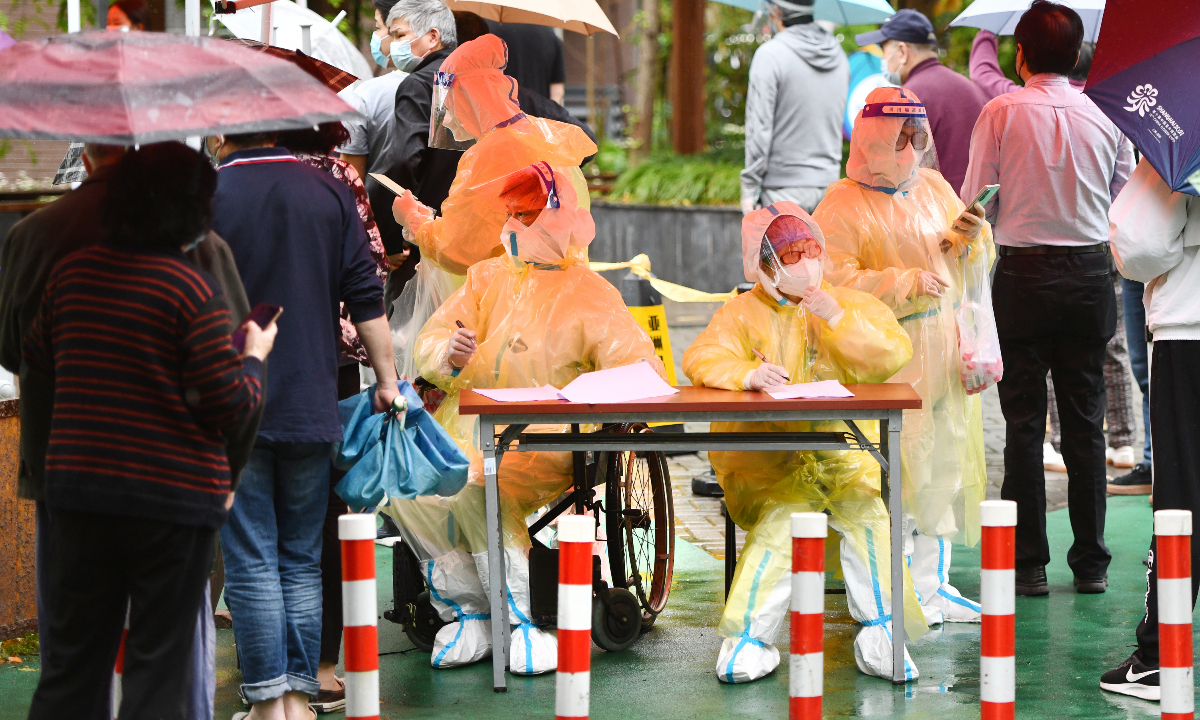
Shanghai residents take nucleic acid testing during the citywide all-member screening on April 23, 2022. Photo: VCG
The Omicron-stemmed flare-up in Shanghai saw the largest drop in the growth of new infections on Monday, with more than 90 percent of new cases discovered in closed-loop management or during centralized quarantine, despite the epidemic still lingering at a high level and the total tally amounting to surpass 500,000.
The city registered 1,661 new confirmed cases and 15,319 asymptomatic infections on Monday. A total of 16,763 cases, or 98 percent of the total 16,980 new infections, were discovered in closed-loop management or during centralized quarantine, the Shanghai health authority announced on Tuesday.
Despite the epidemic still lingers at a high level, the total number of new infections registered on Monday further declined from the previous day by 2,000 cases, a 13 percent drop on the growth, which turned out to be the largest drop since the flare-up started.
The accumulated number of infections in this round of flare-up amounted to half a million as of April 24 since it started at the end of February, with the infections having increased a lot at the early stage in a short period of time, Sun Xiaodong, a deputy director of Shanghai Municipal Center for Disease Control and Prevention, said during the press briefing on Tuesday, noting that the number of infections surpassed 1,000 by mid-March, which increased tenfold every 10 days or so in the following month.
Gene sequencing results show the majority of the viruses that caused rapid spread are Omicron's BA.2 and BA.2.2 mutations, the occurrence and the development of the flare-up is basically consistent with the characteristics of the Omicron variants which have caused outbreaks in other areas at home and abroad, Sun said.
The characteristics of Omicron variants include fast transmission, strong contagiousness, and latency. According to Sun, the average incubation period of the Omicron variants is three to four days, and they can spread to two or three generations within one week. Besides, they have stronger transmission capacity than influenza and previous COVID-19 variants with each infected person being able to spread the virus to 9.5 persons on average when protection measures are not taken.
About 90 percent of the infections are asymptomatic carriers and even those with symptoms just have light symptoms such as a running nose, sneezing and sore throats, which are easily mistaken for the common cold or seasonal flu, which has resulted in delayed medical treatment and latent transmission.
The major reason for the epidemic continuing to linger at a high level is that cross and clusters of infections easily occur in some key areas and venues such as old residential compounds in downtown, urban villages, and large-scale enterprises, which are difficult to manage, Sun said.
The city has taken a multi-pronged approach to curb the spread of the epidemic including speeding up the transfer of close contacts, strengthening screening of personnel at risk, and environmental disinfection.
Since Tuesday morning, a new round of nucleic acid screening in all the areas in lockdown, and under control and precaution was rolled out across the city to consolidate the achievements made amid the fight against the epidemic over the past three weeks.
The epidemic in Shanghai has been tamed in general, but the foundation is still not solid, so we should not take a chance and slack off, Zhao Dandan, a deputy director of the Shanghai Municipal Health Commission, said at the press briefing, adding that swift transferring of positive infections, epidemiological investigations on the spot and settlement of new infections on a daily basis will be carried out to curb community transmission.
Global Times




